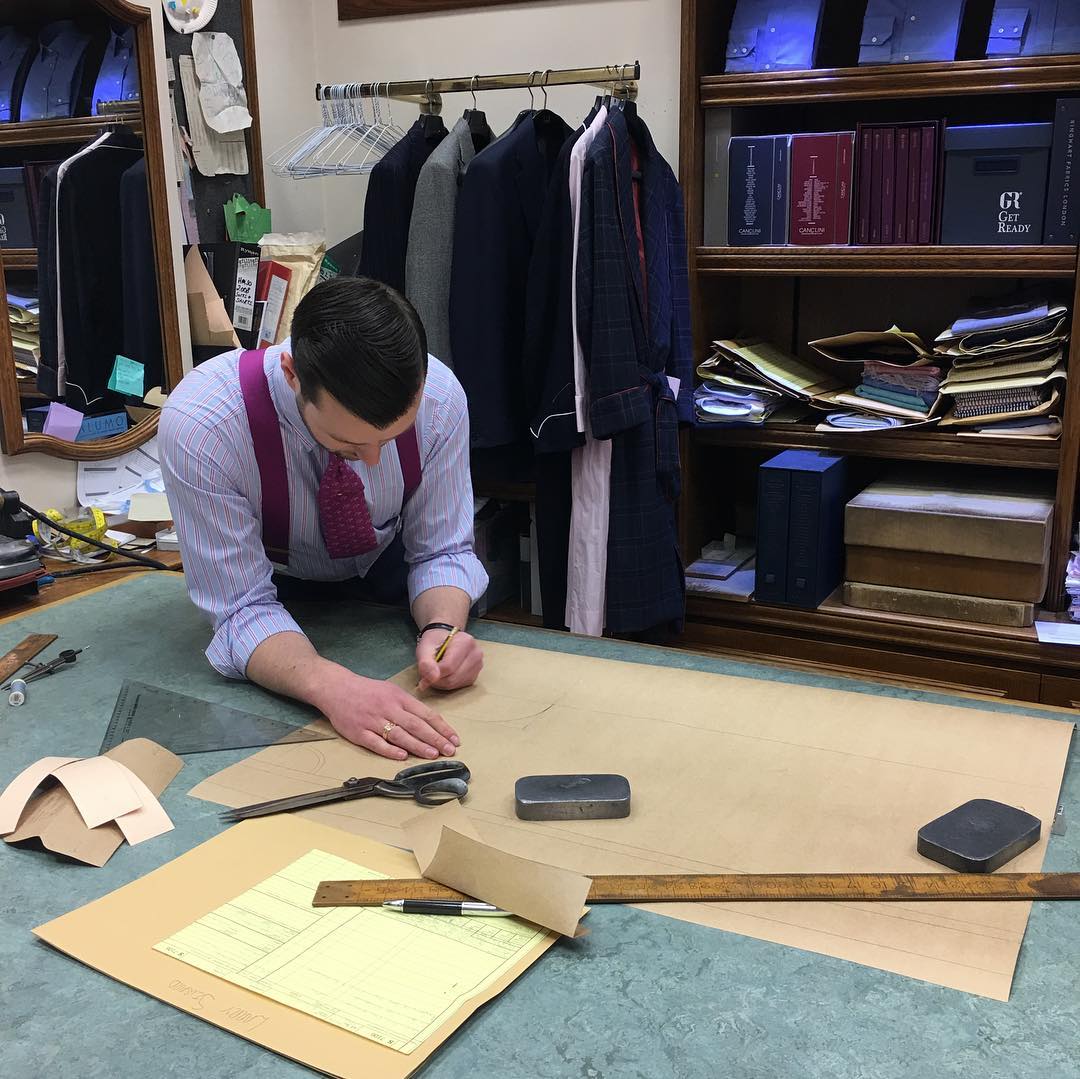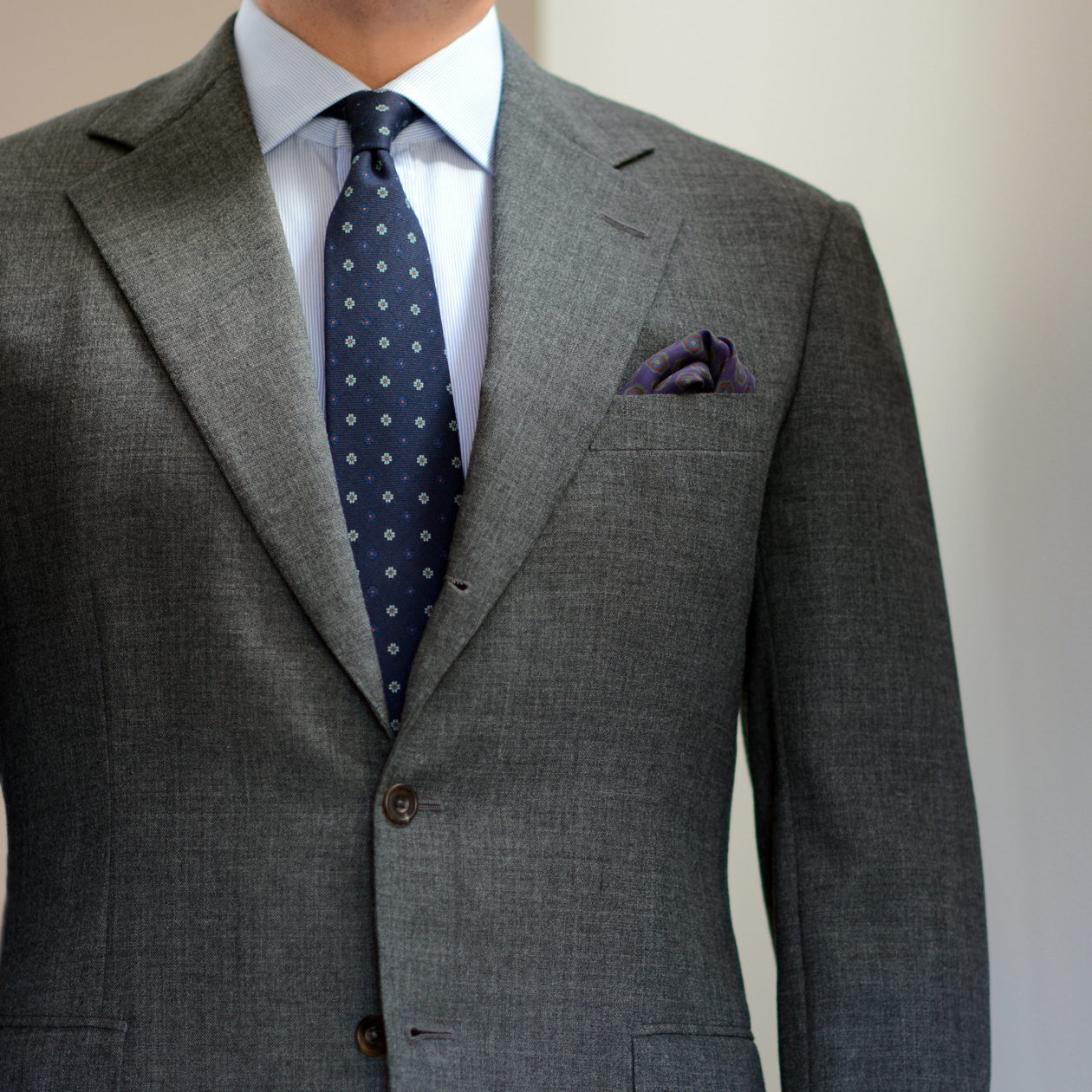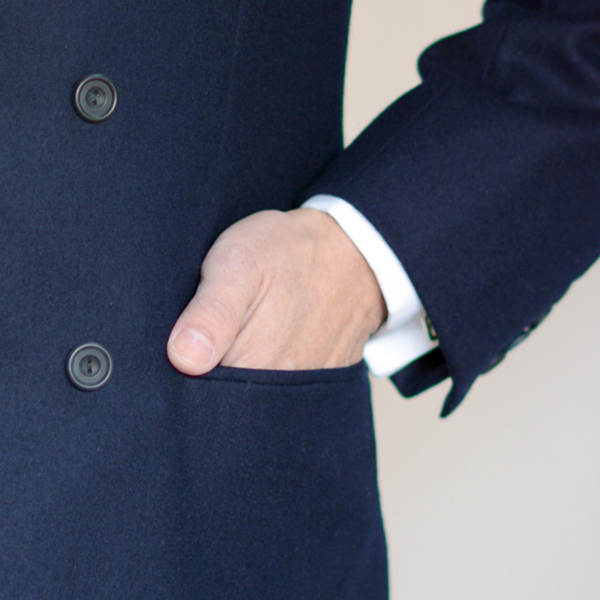
In his book Nothing but the Best, initially published in 1959, Thomas Girtin describes the Golden Age of British craftsmanship. Between the descriptions of how various goods are made — suits, shoes, gloves, umbrellas, guns, and fishing rods among them — Girtin laces character sketches of the craftspeople and their eccentric patrons. The book tells the story of a very simple but noble craft. Many artisans entered their trade after dropping out of school and then climbed to the height of their profession by merely keeping to a high standard. Everything was cut and made from scratch, not even from block patterns, which are increasingly taking over the modern bespoke trade.
Tom Bradbury, the head shirt cutter at Dege & Skinner, is one of the last practitioners of that Old World craft. A hundred years ago, London was teeming with bespoke shirtmakers. Nowadays, there is only a handful, including Dege & Skinner on Savile Row. Bradbury learned his craft after having dropped out of college and then working at high street shops. Since Bradbury was interested in clothes, his uncle suggested that he pick up a trade on Savile Row. The next day, Bradbury put on a suit, walked into Dege & Skinner, and met the Managing Director, William Skinner himself. That was the start of his long career.
Bradbury makes shirts the old way: everything is cut by hand from scratch, including the collar, which is cut with a sharp knife for precision. He’s been at this trade for almost ten years now, having trained under the famous Robert Whittaker, the last head shirt cutter at Dege & Skinner before him. In normal times, Bradbury travels around the world to meet, measure, and fit clients for bespoke shirts, and then goes back to the company’s workshop on 10 Savile Row, where everything is made on-premise.
The thing about shirtmaking is that there’s no room for error. Shirt fabrics only weigh a few ounces per meter, unlike suit or sport coat materials, which typically come in at 14oz or more. With lighter weight materials, and without the structure that goes into a suit jacket or sport coat, any misalignment between the shirt and wearer will show up in the form of messy wrinkles. In bespoke tailoring, shirtmakers aim for perfection. So we asked one of the world’s best shirtmakers what he looks for when fitting a shirt, and how someone might aim for a better fit when buying ready-to-wear. Here’s what Bradbury had to say.

Collar
“When fitting a shirt, I always start at the top and work my way down. The collar is the first thing anyone notices on a shirt, so I pay attention to its shape, size, and depth. A collar should fit close to the neck, but not tight. Some of this will be about the wearer’s preferences, as different people like their collars to fit differently. What might be comfortably snug for one person can be considered too restrictive for another. One of the advantages of getting a custom-made shirt is that the collar will be cut just for you, according to your size and preferences.
When trying on a ready-made shirt, have a shop assistant measure your neck, then try a shirt in that size. If it already feels tight, you may want to size up, as most shirts are already cut with a ¼” shrinkage allowance. If you size up a quarter size, it should be fine. However, if you start sizing up too much, you can throw off the shirt’s proportions, as the size will be graded. As the collar expands, so will the sleeves, length, and body. If you have to size up too much on a shirt, that specific model or cut may not be right for you.”
Shoulder and Yoke
“The shirt’s yoke is more important than you think, as it connects all the other parts of the shirt. The yoke is that back part of the shirt that stretches across your shoulders. It has to sit at the right place, which means the shoulder seams also have to fit correctly. When cutting for a bespoke client, I regard the size of the person. I make a narrower yoke than seen on most ready-to-wear, so that it sits comfortably and gives you better ease of movement. Most people have asymmetrically sloped shoulders, such that one shoulder is dropped a little lower than another. When making a bespoke shirt, we can account for small things like this — the exact slope and pitch of a shoulder, so things fall cleanly.
When trying on a ready-made shirt, pay attention to whether the shoulders fit well. The seams should sit on top of your shoulder bone. Unfortunately, since it’s hard for a ready-to-wear manufacturer to make a garment that exactly matches any specific person’s posture or shoulder slope, sometimes you’ll see lines appear from your shoulder bone going down to your sternum. Granted, shirts are made from fabric, not sheet metal, so wrinkles will appear as you move around. But if you see lines appear when you’re standing still with your arms by your side, that may mean that the shirt’s shoulders don’t precisely match your natural shoulders.”
Chest
“This is again a balancing act, as people have different preferences for how they like their shirts to fit. Some people like a fuller cut; some like it slim. When cutting for a client, I try to get a sense of how they like their shirts to fit.
You don’t want a chest that’s so full that there’s excess material draping along the armhole. Simultaneously, the chest shouldn’t be so tight that you see the buttons starting to pull. A good way to check this is to move around a little. Sit down and see if the placket is starting to pull. Sometimes a slim shirt can look good when you’re standing at attention in front of the mirror, but then not feel comfortable when you move around or sit down. Check to make sure your shirt fits for daily life.”

Sleeve
“Sleeves can have a break just like trousers have a break. That means there’s a bit of excess material in length, so the fabric folds — or breaks — along the line. If your sleeves don’t have any extra fabric, then the cuff will ride up on your arm when you move around. At the same time, if you have too much material, it will look messy. You don’t want your sleeves to fall two or three inches down your arm when you unbutton your cuff. All that extra material is going to bunch up.
When trying on a shirt, try it with your suit jacket or sport coat. You want to show a bit of shirt cuff, generally somewhere between 1/4th to 3/8th of an inch, depending on your preferences. You can check this by standing still with your arms by your side. Now put your arms in front of you. Your shirt cuff should stay relatively stationary. If your cuff rides up your arm, your shirt sleeves are too short.
I also like to have people bend their hands back when they’re wearing their shirt and with the cuffs fastened. If the sleeves have been cut correctly, your cuff shouldn’t crease too much when you bend your hand backward.”
How to Stop Shirt from Untucking
“This is partly about the length and partly about the armhole. A high armhole will allow for better movement. You don’t want it too high, as then it will be uncomfortable. But if you have a low armhole, the shirt will become untucked as you lift your arms.
The other part is the length and gussets. Again, you don’t want a shirt to be too tight around the hips. But when you increase the length, especially from the bottom of the armhole to the bottom of the gusset, a shirt will stay tucked much better throughout the day.”
Getting a Collar to Stand Up Without a Tie
“A shirt collar is going to collapse to some degree if you’re not wearing a coat and tie, as gravity will play its part. This is why the button-down collar style is so popular for casual occasions. Even for business shirts, we’ve been making concealed button-down collars for customers who like to wear their collars open and without a tie. However, if you find that your collar is slipping down throughout the day, it may be because of a bad jacket. If your jacket’s collar isn’t hugging your neck, it will allow the shirt collar to slip down.
Otherwise, we have a term called “spring” in shirtmaking. If I’m cutting for a client who likes to wear a shirt without a tie, but doesn’t want a button-down collar style, I’ll put a bit more “spring” in the collar. This means increasing the curvature of the collar band at the front, where you would fasten it. When you increase the curve in this way, it does a better job of holding up the collar, as the collar is folded onto the collar band. Putting a placket on a shirt can also help the collar stand upright throughout the day, as then the front is less likely to collapse.”
Thanks to Tom for his time! Due to the pandemic, Dege & Skinner has put its international trunk shows on hold. In normal times, they travel to Switzerland, France, Japan, and the United States to meet and fit customers. Shirt prices start at about £295 (excluding VAT), depending on the fabric. Those interested can contact Dege & Skinner to be notified of their next trunk show. The company also has a range of ready-to-wear shirts on its website.







